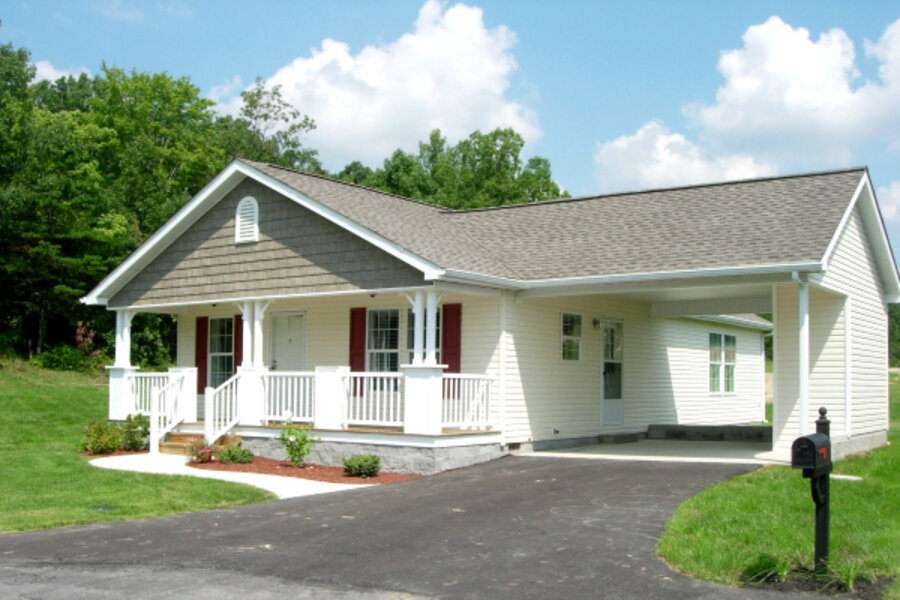Manufactured homes can provide low-cost housing that saves energy too
Loading...
I grew up in rural Kentucky, where deteriorating mobile homes ruled – and spoiled – the landscape. When I grew up, I vowed, I would do something about it.
Little did I realize the solution – one that would help the environment and benefit thousands of families – would involve the very thing I once railed against: manufactured housing. It's been a remarkable journey.
When I became head of an affordable housing organization 13 years ago, I quickly realized the daunting problem I faced: Roughly 2 million families still live in mobile homes built before 1976. These homes produce more greenhouse gases than newer homes and waste significantly more energy – sending utility bills skyrocketing for families that are already struggling to get by.
When these families came to me for help, I would urge them not to buy another manufactured home. I told them these homes weren't constructed as well as traditionally built homes. Worse, many manufactured homes lacked a permanent foundation – meaning buyers could not qualify for a low-interest mortgage under federal rules. That left buyers paying much higher interest rates.
Yet despite all my efforts, families were snapping up manufactured homes because they were affordable, easily financed, and could be constructed in a matter of weeks. Site-built homes were simply too expensive and took too long to build for many families needing a home.
I was getting killed by the lure of factory-built homes. Of the families who came to us for help, some 90 percent bought a manufactured house. I was fighting a losing cause.
Then it hit me: What if manufactured homes weren't the problem, but rather the solution? What if I worked with the manufactured housing industry to get low-income families into well-constructed, energy-efficient homes built with the right foundations?
I started a new organization called Next Step to connect the manufactured home industry with affordable-housing organizations across America. I found a partner in Clayton Homes, the largest maker of factory-built homes in the nation.
What I learned: Manufactured homes can be attractive, grow in value, and open the door to home ownership for millions of families. These homes can truly change people's lives.
But they must be built the right way. That's why Next Step partnered with Clayton Homes to put families into homes that are carefully designed to increase energy efficiency; engineered to be affordable; built to the highest standards; and placed on a permanent foundation so the home buyer qualifies for a low-interest mortgage.
Not surprisingly, some affordable-housing advocates are more than a little skeptical of our efforts. Here's what I tell them: Clayton is the nation's biggest manufactured-home builder, so they can buy high-quality materials in bulk and pass along the savings. And because their homes are built inside a factory, they have far less construction waste and don't suffer weather delays like conventional builders.
Best of all, we're getting families out of older mobile homes – something that's critically important for all of us.
Mobile homes constructed before 1976 – when the federal government began regulating factory-built homes – are deteriorating and increasingly problematic for the environment.
Our goal is to get these families into manufactured homes that are far nicer and far more energy efficient. So far, more than 100 families have moved into these homes under our nationwide program.
We work with Clayton Homes to build all of our homes to Energy Star qualifications – saving homeowners significant money on their utility bills. Each home features energy-efficient heating and cooling systems as well as high-performance windows and insulation– resulting in energy savings of up to 30 percent over standard factory-built homes.
So far, we've helped more than 100 families purchase manufactured homes that we project will save them almost $4 million on their utility bills and $12.5 million in interest over the life of their 30-year loans– while reducing greenhouse-gas emissions by more than 9,000 tons.
The results are plain to see. One elderly woman, for example, had lived in an older mobile home for years before moving into a Next Step home. In the next few months, her utility bill dropped so much that her power company thought she had passed away. Contacted by a utility worker, she was happy to report that she was, in fact, alive and well, living in a nicer, larger, and more energy-efficient home.
Growing up, I never imagined I'd be extolling the virtues of manufactured housing. But things change. People change. And even a deeply held prejudice is best left in the past.
• Stacey Epperson is president and CEO of Next Step, a nonprofit program that connects the manufactured homes industry with affordable-housing organizations across America. You can learn more at www.nextstepus.org.





